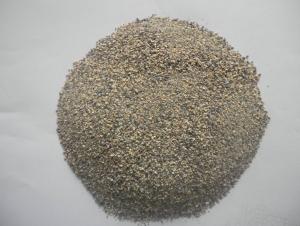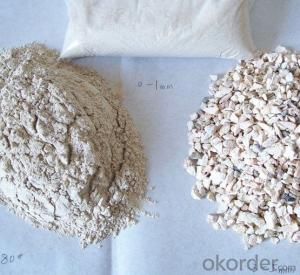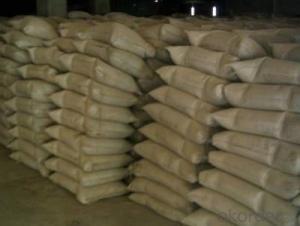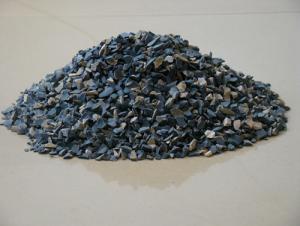Raw Materials for High Alumina Refractory Cement
- Loading Port:
- China Main Port
- Payment Terms:
- TT OR LC
- Min Order Qty:
- -
- Supply Capability:
- -
OKorder Service Pledge
OKorder Financial Service
You Might Also Like
Specifications
Refractory Cement
high alumia refractory
1.Quick hardening and early strengthening
2.Good quality with competitive price
High Alumina Refractory Cement
Applications
1.Used as building refractory cement.
2.Furnaces lining material of metallurgy industry, heat treatment furnace.
3.Furnace lining material of incineration of garbage, recirculating fluidized bed furnace.
4.Furnaces lining material of chemical industry and construction industry.
Typical Features:
1.Low thermal conductivity, excellent thermal insulation, low liner shrinkage.
2.Good integrity with furnace lining, long service life, easy operation, could be shaped freely.
3.Allow direct contact of fire, suitable for various atmosphere.
4.High strength and good thermal shock resistance.
Specifications:
Item | Unit | 75% Alumina Index | 40% Alumina Index | |
Al2O3 | % | ≥75 | ≥40 | |
CaO | % | ≥2.5 |
| |
Bulk density | 110°C×24h | g/cm3 | ≥2.65 | ≥2.3 |
1100°C×3h | g/cm3 | ≥2.65 | ≥2.3 | |
Crushing strength | 110°C×24h | Mpa | ≥45 | ≥40 |
1500°C×3h | Mpa | ≥70 | ≥60 | |
Rupture strength | 110°C×24h | Mpa | ≥6 | ≥6 |
1500°C×3h | Mpa | ≥10 | ≥8 | |
Linear change rate at 1100°C | % | -0.1~-0.5 | ±0.5 | |
Highest Application Temperature | °C | 1500 | 1350 | |
FACTORY:


- Q: hat kind of fire retardant materials are there
- At present, there are mainly organic and inorganic flame retardant materials, halogen and non halogen. Organic flame retardant materials are represented by bromine, nitrogen and phosphorus and its compounds; Inorganic fire retardant materials include antimonous oxide, magnesium hydroxide, aluminum hydroxide, and silicon. Generally speaking, organic flame retardant materials have a good affinity, and can be added in the plastics. Brominated flame retardant agent occupy the absolute advantage among organic flame retardant system, though it’s “controversial” in terms of environmental protection, it has been difficult to have other flame retardant system replaced.
- Q: What are the materials for refractory materials? What are their names?
- Acid refractory with silicon oxide as the main component, are commonly used in brick and clay brick. Silica is silica containing more than 93% silica products, raw materials used in silica, silica and other waste, the acid resistance of slag erosion ability, high load softening temperature, volume shrinkage after repeated burning, or even a slight expansion; but it is vulnerable to the erosion of basic slag, low thermal shock resistance. The brick is mainly used for thermal equipment of glass furnace, coke oven, acid furnace etc.. Clay brick with refractory clay as the main raw material, containing 30% to 46% of alumina, weak acid refractory material, heat shock resistance, resistance to acid slag, widely used.
- Q: whether the fire resistant level of aerated concrete building blocks can reach the grade one?
- the fire resistant level of aerated concrete building blocks can reach the grade one level. Aerated concrete strength grade shall be divided according to the concrete cubic compressive strength value. Use the symbol C and the cube compressive strength value (in N / mm2 or MPa gauge) to express. According to GB50010-2002 "concrete structure design specifications" provisions, ordinary concrete is divided into fourteen levels, namely: C15, C20, C25, C30, C35, C40, C45, C50, C55, C60, C65, C70, C75, C80 .
- Q: How long usually will the A-level fireproof materials prevent the flame?
- Having a fire resistance test on any building components -----according to the standard time-temperature curve. This period starts from the time when affected by fire and ends up with losing the ability to support or to insulate fire or the integrity of the components. It can be expressed in hours. A-level fireproof materials can last for 2 hours.
- Q: What is the classification standard of fireproofing material levels?
- the following are the criteria: Currently fire materials levels mainly include:class A : incombustible building material,which almost doesn't burn. class A1: non-combustible, without open fire, class A2, non-combustible, it needs to measure the smoke and be qualified. class B1: nonflammable building material: nonflammable materials have good flame resistance function. when it contacts open fire or is under high temperature, it's difficult to burn and be spreading rapidly, and will stop burn after removing the combustion?source. class B1: combustible?building?materials: combustible materials have good flame resistance function. when it contacts open fire or is put in the air at high temperature, it will immediately burst into flames, and easily result in the spreading of fire, such as wooden column, timber roof truss, timber beam, wooden stairs, etc. class B3: inflammability building materials, without any flame resisting effects, easy to burn, and has large danger of fire disaster. In addition, according to different standards, fire-proofing materials' grade partition is different: DIN4102: A1, A2, B1, B2, B3: EN13501-1 A1, A2, B, C, D, E, F
- Q: What are the construction measures of refractory material in winter? Please descriptive briefly.
- Binding agent should be attaced great importance to when construction is conducted in winter. Generally if the bingding agent is water or cement, antifreezing measures should be taken.
- Q: What materials are needed to make the amorphous refractory bricks?
- The amorphous refractory brick is composed of a certain proportion of aggregate and powder, a binder and an additive, and it can be directly used or used after allocation with some liquids. The amorphous refractory brick is a new type of refractory material without calcination, its refractoriness is below 1580℃.There is a wide variety of refractory materials. According to the production method and usage thereof can be divided into concrete, castable, plastic refractory, ramming refractory, gunning mix, sling refractory, coating material, dry ramming mix , fire clay, and all kinds of repairing mass(Asphalt combined with large surface charge compensation, Martin also belongs to the shape of the amorphous refractory material).
- Q: What high-molecular polymers can be used as fire-resistant material binder?
- Melamine resin should be compounded with fire-resistant material and acrylic acid material is easy to burn. But high-molecular polymers can be used along with the above two. Polysulfone is featured by heat resistance and high temperature resistance. Polyurethane is difficult to process and compound with fire-resistant material. Phenolic resin is not easy to burn. Epoxy is expensive and self-extinguishing once away from fire.
- Q: What are the common refractory insulation cotton material?
- High aluminum, clay brick, aluminum silicate fiber module and so on, inorganic types are glass wool, rock wool, foam glass etc.. Organic: the best one is phenolic foam, compround phenolic foam cement layer is a-level. Aerated concrete and other refractory thermal insulation material mainly refers to the inorganic thermal insulation materials and compround thermal insulation material, expanded perlite, foam clay It is applicable for buildings that have high requirement for fire proof level, foamed concrete, volcanic ash glass.
- Q: Is there a worker in (Jigang refractory plant)?
- Ha ha, base should be rest, you won't give you money, Hugh or those money, endlessly is your dedication. Should be double cease, ah, how do you say four days?. In theory, it's five days off now, and the three day of that is from the chairman to every employee.
Send your message to us
Raw Materials for High Alumina Refractory Cement
- Loading Port:
- China Main Port
- Payment Terms:
- TT OR LC
- Min Order Qty:
- -
- Supply Capability:
- -
OKorder Service Pledge
OKorder Financial Service
Similar products
Hot products
Hot Searches
Related keywords
























